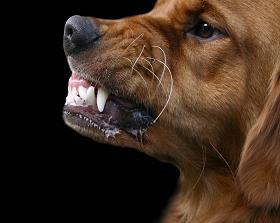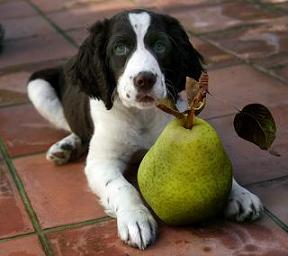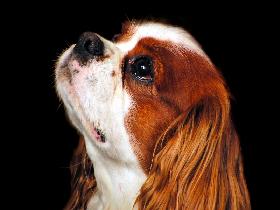Dog Food Aggression & How To Prevent It
Dog food aggression is one of those dog behavior problems that is difficult for us humans to fully understand. It just doesn't seem to make sense that your dog would consider you a threat to his/her food resource. I mean you gave him the food in the first place, and if you feed your dog the same kind of foods that I do, it's not all that appealing anyway!
But, what is your dog thinking?
If your dog glares at you, snarls, growls and positions himself between you and the food he is actually saying to you "this is mine, go away, find your own". He is basically telling you that he considers himself as the leader or alpha dog in your household. Dog food aggression (sometimes called canine possession aggression or food guarding) is a dominance issue, it is serious and needs to be addressed immediately. It won't simply just go away.
telling you that he considers himself as the leader or alpha dog in your household. Dog food aggression (sometimes called canine possession aggression or food guarding) is a dominance issue, it is serious and needs to be addressed immediately. It won't simply just go away.
We've all made the mistake of laughing and even encouraging our feisty little dogs when they first display the "cute" signs of dog food aggression. Don't fall into this trap! Food or toy aggression in dogs should never be tolerated as you never know when it can escalate into something more dangerous for you or a family member.
[google_ad:DOTR_CMS_468x60_InArticle1]
Why Does Your Dog Display Dog Food Aggression?
Canine possession aggression can be triggered by any number of factors but in most cases it can be attributed to one of these common causes:
- Your dog is desperate for this food, in his mind he doesn't know if or when he will get more food. Therefore he protects or guards his food, just like he would have done in a pack situation in the wild.

- Your dog may begin to see you as someone who is always taking good stuff away. He comes to view you more as a threat than a provider (you've got to turn this thinking around).
- Dog food aggression can be part of the general confusion regarding who the leader is in your owner-dog relationship. Often food aggression is not an isolated incident - it's something you must rectify. To discover how to establish yourself as your dog's fair and respected leader I recommend you study and implement these training methods - dogproblems.com membership.
- It's possible that your dog doesn't even understand that his dog food aggression is an unacceptable behavior. In such cases there is an obvious communication breakdown between human and dog.
General Rules For Correcting Food Aggression In Dogs
- Keep in mind that your dog's snarling/barking/growling is actually rewarded and therefore reinforced each time you back off. Your dog believes his behavior has worked and is much more likely to try the same thing again in future. Note: This doesn't necessarily mean you shouldn't back off in this situation - more on this later.
- If your dog is directing his aggression towards other dogs the best solution is to simply separate them at meal times. Feed them in different rooms or in their crates.
- Involve all of your family members in this dog food aggression training. You must convey a unified and consistent message to your dog in order to successfully reverse this behavior.
- Take control of feeding time. You control the time and place of dinner time - own the food!
- Make your dog earn any food. Just simple tasks like requesting a sit or a down stay before you put the food bowl down are a good start.
- Make it clear to your young puppies that it's good to have people around when they are eating. If you do this from day one you will almost certainly prevent dog food aggression problems.
- If you encounter dog food aggression it is a good idea to feed your dog after you and your family eat. This again is a throwback to your dog's pack mentality where the alpha dog or leader of the pack (which is you) eats first - your dog will understand this technique.
- Don't let your dog "win" the food through his growling, this would reward the very behavior you are trying to eradicate. Don't bully or intimidate your dog though, it's much better to make him actually like having you around at meal time (follow the tips below to achieve this).
- Never respond to canine possession aggression with aggression of your own. In essence what this does is to lock you and your dog into a battle of wills. Your dog's next move will most likely be to step up his level of aggression in order to counter your action.
Dog Food Aggression
Training Techniques
Firstly, be careful. If you believe your dog poses any real physical threat to you or family members I'd advise getting professional help. Speak to a professional dog trainer or animal behaviorist for more information.
Below is a list of training techniques which could help your dog overcome his dog food aggression. Remember all of these techniques are designed to work towards reconditioning your dog to enjoy having you around anytime.
Mix it up, show your dog who is boss!
- Hand feed your dogs. Eventually you should even be able to stick your hands into your dogs bowl while he is eating without any sign of aggression.
- Stroke and pet your dog while he is eating and at the same time talk to him in a calming tone. All you are doing at this point is showing your dog that it is a good thing for you to be around.
- Stand at a distance your dog is comfortable with, then gradually reduce this distance over time. You can flick a few treats in (or near) the food bowl as you slowly reduce the distance.
- Put your dogs bowl down with nothing in it, your dog will look back at you as though you are crazy. He'll then literally beg you to come over and fill his bowl.
- Feed your dog as normal but hold back a few pieces of his meal. When he is finished licking the bowl, he'll look back up at you, then you can come over and give him the remaining food.
- Drop a few of your dog's very favorite treats into his bowl each time you walk past it. After a while of doing this your dog will welcome the sight of you approaching the bowl.
- When your dog is eating, call him over to you, when he gets to you reward him, make it worth his while then let him back to the food bowl.
An example of a dog that suffers
Canine Possession Aggression or Resource Guarding
- While you are preparing your dogs meal put him in a down-stay or sit position, only release him from your command once you have put his bowl down. By doing this you are controlling meal time and establishing (or re-establishing) your role as your dogs leader. To learn more about how to be a strong and respected leader I recommend a dogproblems.com membership.
- Work with another family member on this technique. Put your dog in his collar and leash and have him sit with your helper while you prepare the food. When you are ready release your dog and allow him his food. Again you are controlling the situation.
- Try the "Trade Up Method". What you do is take away the food or toy your dog is guarding, and replace it with something better. You can use an obedience command such as "give" or "leave it" to encourage your dog to release the precious resource he is guarding. You then take this resource (the food or toy) and give the trade up item to your dog. Once your dog has finished with the new item, you can then give back the resource you took away. This technique proves to your dog that he will receive something great for giving something up, it will recondition his thinking.
- Every time you are with your dog have him in a pinch or prong collar with a leash attached. Whenever he displays any signs of dog food aggression you immediately administer a correction to your dog by snapping on the leash. What this does to your dog is build a negative association to the act of his food guarding antics. Note: I personally don't advocate this method but many experienced dog trainers swear by it.

Is your dog food safe? - what is the best dog food?
Check out some more dog obedience training commands.
Please consult the services of a Professional Dog Trainer, Behaviorist or Veterinarian before implementing any of the advice contained on this site.











 Your Privacy Choices
Your Privacy Choices